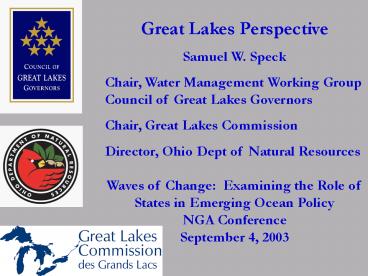Annex 2001 PowerPoint PPT Presentation
1 / 23
Title: Annex 2001
1
Great Lakes Perspective Samuel W. Speck Chair,
Water Management Working Group Council of Great
Lakes Governors Chair, Great Lakes
Commission Director, Ohio Dept of Natural
Resources Waves of Change Examining the Role
of States in Emerging Ocean Policy NGA
Conference September 4, 2003
2
Great Lakes Basin
3
Great Lakes
- Largest system of fresh water on the earth
- 20 of worlds supply of fresh surface water 90
of United States supply - 6 quadrillion gallons of water over 94,000 square
miles of lake surface - Basis for multi-billion dollar industries in
every state and province - Intensive, multiple use under a complex
multi-jurisdictional management structure - 895 billion gallons withdrawn/used in-stream
daily (59 billion excluding hydroelectric)
2.64 billion consumed
4
- Binational agency representing Great Lakes states
and provinces - Formed mid 1950s via state law and 1968 via
federal consent as an interstate compact - Provincial associate membership began in 1999
5
Great Lakes Commission
- Promotes the informed use, management and
protection of the water and related natural
resources of the Great Lakes Basin and St.
Lawrence River - Addresses resource management, environmental
protection, transportation and sustainable
economic development issues - Functions are information sharing, policy
research and development, and advocacy
6
- Non-partisan partnership of
- eight Great Lakes Governors
- Formed in 1983
- Premiers of Ontario and Quebec
- are associate members
- Mission is to encourage and facilitate
- environmentally responsible economic growth
7
Great Lakes Charter
- 1985 Good-faith agreement between Great Lakes
Governors and Premiers - Framework for protecting Basin waters from large
scale diversions and consumptive uses - Establishment of water management principles
8
Factors Leading to the Annex to the Great Lakes
Charter in 2001
- 1986 U.S. federal statute (WRDA)
- - Prohibits diversions unless approved by
- Governors of all Great Lakes States
- - Allows veto without standards
- - Regulates first drop (no threshold)
- - Ontario Quebec not subject to U.S.
- federal law
- - In-basin consumptive uses not incl
- - Question whether ground water incl
- 1998 Nova Group proposal
- 1999 Recurring lower lake levels
9
October 1999Governors and Premiers Commitment
- Develop new agreement
- Develop new common standard for water removal
based upon protection of the water resources - Secure funds to develop a better base of water
use data
10
Governors and Premiers Principles for Water
Management Regime
- Protect the resource
- Be durable
- Be simple
- Be efficient
- Retain authority in the Basin
11
Great Lakes Charter Annex
- Signed June 18, 2001
- In contrast to WRDA the Annex would
- - Include Ontario and Quebec
- - Include in-basin consumptive uses
- - Include ground water
- - Commit to improve the sources applications
- of scientific information re
- management of Basin waters
12
Annex Directives
- New decision making standard
- New set of binding agreements
- Decision support system
- Public participation
- Further commitments
- Improve sources applications of scientific
information, including role of ground water
13
Draft Decision Making Framework
- Regional review by State-Provincial body for
large diversion and consumptive use proposals - Individual State or Provincial review for smaller
diversion and consumptive use proposals
14
Annex Implementation
- June 2004 - timeline to develop agreement
- State-Provincial agreement
- State legislation such as approval of an
interstate compact - Provincial legislation
15
Great Lakes Priorities
- March 1, 2001 Congressional Great Lakes Task
Force request to Governors - Common set of priorities for Great Lakes
restoration - CGLG Priorities Task Force
- April 2003 GAO Great Lakes Report
- S 1398 and HR 2720
16
Great Lakes Priorities
- Leadership role of Great Lakes Governors and
Premiers is key to establishing policy priorities
for a comprehensive restoration plan - Priorities will reflect broad goals such as
protection of human health, restoration of
habitat, control of invasive species
17
Summary
- Great Lakes Basin Commission compact
- Council of Great Lakes Governors partnership
- Great Lakes Charter good-faith agreement
- Great Lakes Charter Annex good-faith agreement
that calls for binding agreements which are being
developed - Great Lakes Priorities Task Force partnership
- WRDA U.S. federal law
18
Regional Management
- Operationalize Regional Agreements
- Compact
- Good-faith agreement
- U.S. federal law
- Currently working towards meeting intent of the
Annex which calls for binding agreements
19
Regional Management
- Biggest Challenges
- Resolving legal issues
- Deriving consensus among highly diverse interests
- Developing a scientific basis for decision making
- Bridging different histories of water regulations
within the respective jurisdictions
20
Regional Management
- What Could Be Done Differently?
- Better monitoring and research to provide a
scientific basis for decision making - Better coordination, definition of objectives,
and measurement of results among existing
programs (GAO Great Lakes Report)
21
Regional Management
- Lessons Learned
- Sustainability of the resource is the critical
bridge for bringing people together - Improvement in scientific information is needed
for good decision making and setting standards - Effective management of water resources in the
Great Lakes Basin requires an international
partnership - Bridging group such as the Great Lakes Commission
is necessary to bring diverse interests together
22
Regional Management
- What Can the Federal Government/Ocean Commission
Do? - Recognize the key role of the States and
Governors - Recognize the Great Lakes as part of the focus of
our national ocean policy - Promote regional, watershed-based approach to
policy development - Ensure the Great Lakes receive full and equitable
share of federal support and funding
23
If there is magic on this planet, it is
contained in water. Loren Eiseley, The Flow of
the River

